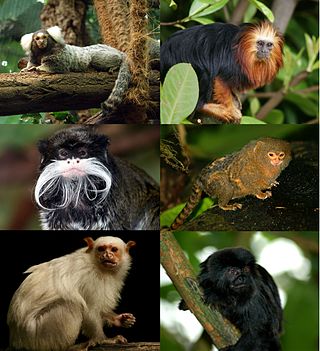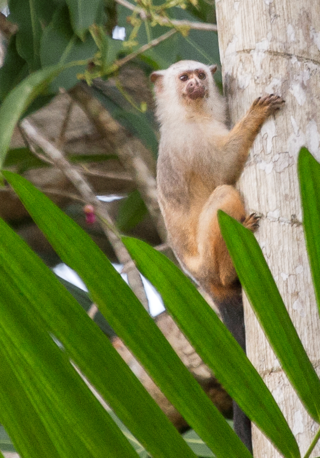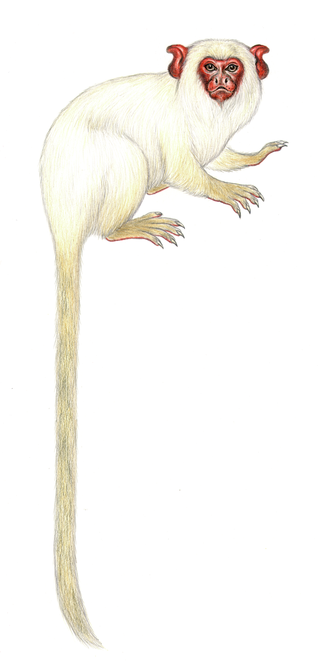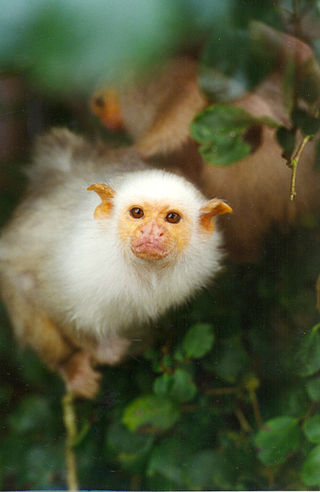
The Callitrichidae are a family of New World monkeys, including marmosets, tamarins, and lion tamarins. At times, this group of animals has been regarded as a subfamily, called the Callitrichinae, of the family Cebidae.

Wied's marmoset, also known as Wied's black-tufted-ear marmoset, is a New World monkey that lives in tropical and subtropical forests of eastern Brazil. Unlike other marmosets, Wied's marmoset lives in groups consisting of 4 or 5 females and 2 or 3 males. They are matriarchal, and only the dominant female is allowed to mate. Like other marmosets, the offspring are always born in pairs.

The silvery marmoset is a New World monkey that lives in the eastern Amazon Rainforest in Brazil.

The buffy-tufted marmoset, also known as the buffy tufted-ear marmoset or white-eared marmoset, is a New World monkey that lives in the forests on the Atlantic coast of southeast Brazil. Of all the marmosets, it has the southernmost range.

The black-tufted marmoset, also known as Mico-estrela in Portuguese, is a species of New World monkey that lives primarily in the Neo-tropical gallery forests of the Brazilian Central Plateau. It ranges from Bahia to Paraná, and as far inland as Goiás, between 14 and 25 degrees south of the equator, and can commonly be seen in the City of Rio de Janeiro where it was introduced. This marmoset typically resides in rainforests, living an arboreal life high in the trees, but below the canopy. They are only rarely spotted near the ground.

The Roosmalens' dwarf marmoset, also known as the black-crowned dwarf marmoset, is a small New World monkey native to the Amazon Rainforest, on the east bank of the lower Madeira River, and the west bank of the Aripuanã River, in Brazil. It has the smallest distribution of any primate in Amazonia. This marmoset has several unique attributes, which has resulted in it sometimes being placed in the monotypic genus Callibella. However, genetic analysis has subsequently resulted in its being classified within the genus Mico.

The Santarem marmoset, also known as the black and white tassel-ear marmoset, is a marmoset endemic to the Brazilian states of Amazonas and Pará.

The Maués marmoset is a marmoset endemic to Brazil. It is found only on the west bank of the Maués Açu River, in the Amazonas state.

The Emilia's marmoset, also known as Snethlage's marmoset, is a marmoset endemic to Brazil. It is found only in the Brazilian states of Pará and Mato Grosso. It was named to honour German-born Brazilian ornithologist Emilie Snethlage.

The black-mantled tamarin, Leontocebus nigricollis, is a species of saddle-back tamarin from the northwestern Amazon in far western Brazil, southeastern Colombia, north-eastern Peru and eastern Ecuador.

The golden-mantled tamarin is a tamarin species from South America. It is found in Ecuador and Peru, specifically in the upper Amazon (lowland), east of the Andes in Ecuador, and Northeast Peru; between the Rio Curaray and Rio Napo in Peru.

Graells's tamarin, Leontocebus nigricollis graellsi, is a subspecies of the black-mantled tamarin from the northwestern Amazon in southeastern Colombia, eastern Ecuador and northeastern Peru. It differs from other black-mantled tamarins in having a dull olive-brown lower back, rump and thighs. However, molecular genetic analysis does not support treating Graell's tamarin as a separate species from the black-mantled tamarin.

The Rio Acarí marmoset is a marmoset species endemic to Brazil. It was first described in 2000.

The gold-and-white marmoset, also known as the golden-white tassel-ear marmoset, is a species of marmoset, a small monkey endemic to the Amazon rainforest in eastern Amazonas state, Brazil.

The Hershkovitz's marmoset, also known as the Aripuanã marmoset is a marmoset species endemic to the south-central Amazon rainforest in Brazil. The common name is a reference to American zoologist Philip Hershkovitz.

The white marmoset, or golden-white bare-ear marmoset, is a species of marmoset, a small monkey endemic to the Amazon rainforest in Pará, Brazil.

The Marca's marmoset is a species of marmoset that is endemic to the Amazon, in the Aripuanã-Manicoré interfluvium in Brazil. Its body is light grey, with orange legs, a black tail, a pinkish face, and naked ears. It is about 9 inches (23 cm) long, excluding the tail, and it has a 15-inch (38 cm) long tail. It weighs about 12 ounces (340 g).

The black-headed marmoset is a marmoset species endemic to Brazil. It inhabits humid tropical rainforest, mostly second growth and edge; the distribution is not exactly known but is thought to be Rio dos Marmelos in the north and east, Madeira River in the west and Ji-Paraná River in the south.

The Satéré marmoset is a marmoset species endemic to Brazil.

Mico is a genus of New World monkeys of the family Callitrichidae, the family containing marmosets and tamarins. The genus was formerly considered a subgenus of the genus Callithrix.























